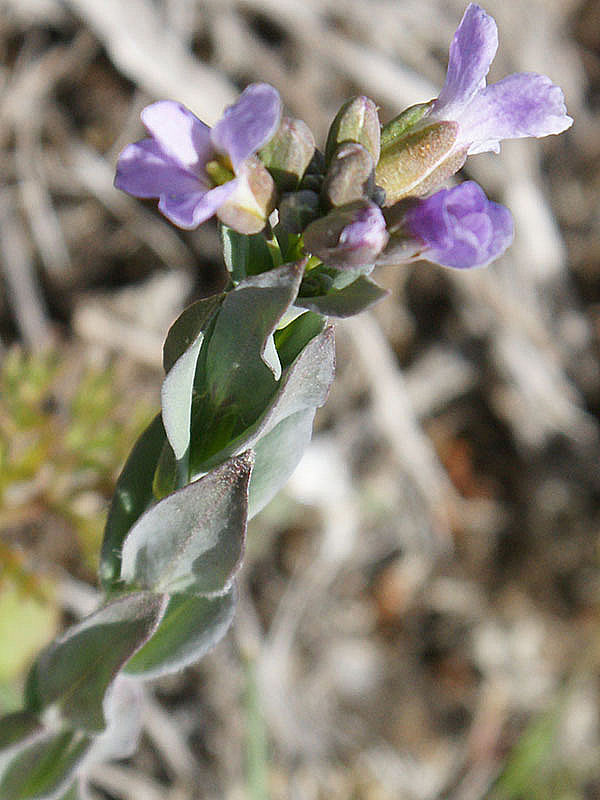Boechera pauciflora / elegant rockcress
- small, insignificant brassica on rocky soils, with sagebrush
- rosette of small, hairy, spatulate leaves
- single flowering stalk, 6″ or more tall, covered with clasping, hairy leaves
- flowers 4-petals, purple (usually) flowers with yellow centers
- may be seen after snowmelt parasitized with yellow pseudoflowers
Also known as: Columbia rockcress, small-flowered rockcress, few-flowered rockcress, hairy stem rockcress, sicklepod rockcress
Synonym: Arabis sparsiflora
Boechera pauciflora first came to my attention not as a short, fuzzy plant with purple flowers, but as a short plant with what looked yellow flowers but weren’t. The yellow clearly stood out in the early spring, brown, dead left-overs from last year, and that caught my attention. But what I was seeing, was a plant parasitized by the fungus, Puccinia monoica. That part of the story can be found on this site at “On pseudoflowers and parasites.”
Without the fungus, the elegant rockcress, where I have found it in the valley, is a very short plant growing with sagebrush just after snowmelt. It is a biennial or short-lived perennial growing from a (usually) branched caudex. It has a basal rosette of “spatulate” leaves; basically this means they are sort of elliptical but have significant petioles so they look like spatulas (but very small). The vegetative plant photo in the gallery shows these well. Mostly, they are hairy, and the trichomes are cross- or star-shaped; with a hand lens, they are sort of interesting looking.
The specific name, pauciflora, comes from the fact that (usually) it puts up a single flowering stalk. As the single flower stalk bolts, the stem is covered with sessile, clasping, hairy leaves to the extent that the stem itself isn’t really visible. At the top of that, there is a cluster (actually, a many-flowered raceme) of teeny, 4-petaled purple flowers with yellow centers. In addition to purple, the flowers can range from white to deep red-violet. The sepals are also frequently purple-ish and hairy. Several sources say that the raceme is a loose one, and perhaps it will elongate in the Valley, but right now, all I have seen are rather tight.
The fruits of this rockcress are sickle-shaped siliques that either stick out or hang down. A bit later in the season, I will add photos and a bit more about them once I have seen them.
B. pauciflora is well adapted to rocky soils in sagebrush areas where the summers are dry. But it can be found elsewhere if you have the search image in your mind and spend all your time looking for very small things on the ground (like you had lost your keys). Like many other brassicas, overall, the elegant rockcress doesn’t much care where it lives as long as it can get in and out before bigger things overtop it, i.e. it is a spring ephemeral. Because of its size, mostly this includes exposed, rocky areas.
Interesting bits – The first bit is that this species may reproduce by apomixis, meaning that all the plants in a community are clones. It is possible that this feature arose by hybridization of two other Boechera spp. to form this one. On the other hand, there may be both asexual and triploid populations as well as diploid ones.
The really (ecologically) interesting bits about this plant, however, concern the relationship between it and a parasitic fungus, Puccinia monoica. The photos in the gallery with what look like yellow flowers are of parasitized plants. As the fungus grows inside the leaves and stems, it completely reprograms gene expression in the plants. It neuters its host, stops it from forming flowers, and instead, makes it form these pseudoflowers. Pseudoflowers are basically altered leaves that look and smell like real flowers. In fact, they look like real flowers in both the visible and ultraviolet wavelengths that insect pollinators see. Pseudoflowers also produce insect-attracting nectar-like substances. And on each pseudoflower are hundreds of small cups that produce the spores for one stage of the fungal life cycle. Insects get covered with these and carry them to other infected plants, where something akin to pollination occurs.
Again, that part of the story can be found on this site at “On pseudoflowers and parasites.”
| Color | |
|---|---|
| Family | |
| Blossom size | |
| Inflorescence size | |
| Inflorescence type | |
| When? | |
| Where? |




